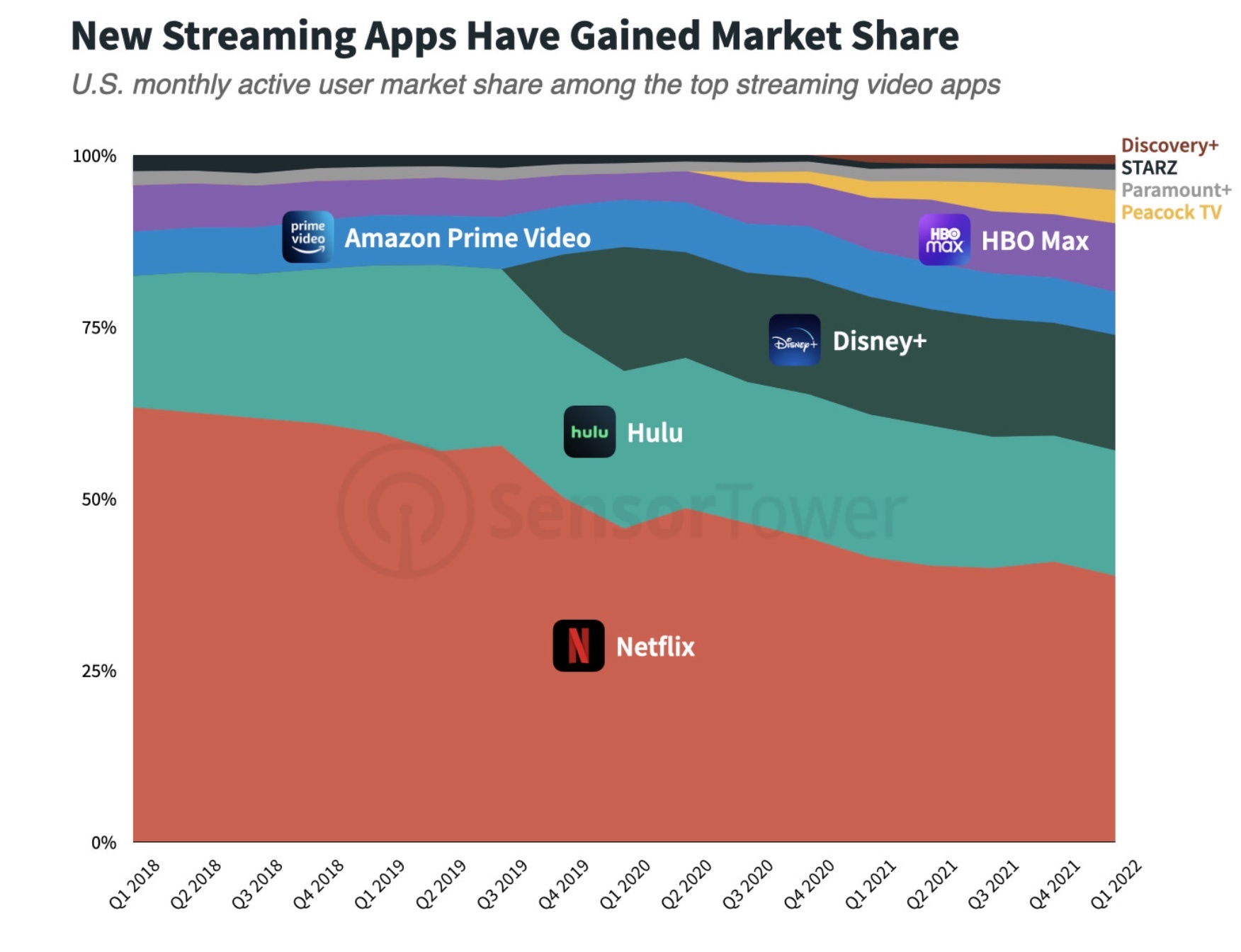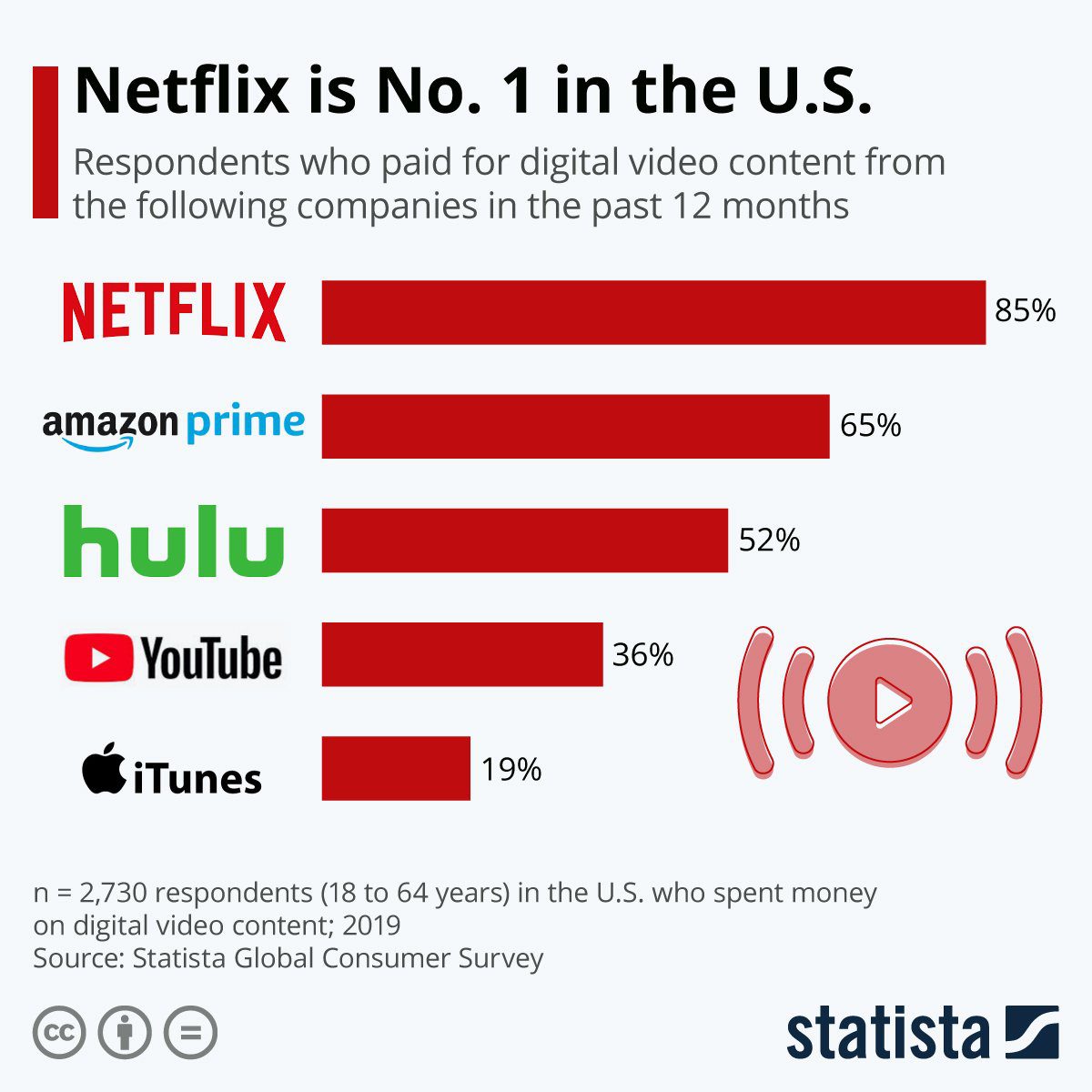Netflix has become a household name when it comes to streaming services, but how exactly does its market share stack up against competitors? In today's world of streaming wars, understanding Netflix's position is crucial for anyone interested in the entertainment industry. Whether you're an investor, tech enthusiast, or just a fan of binge-watching, this article dives deep into the numbers, trends, and challenges shaping Netflix's market share.
Let's be real, everyone knows Netflix. It's like that one friend who always shows up at parties with the best snacks. But behind the scenes, Netflix is fighting hard to maintain its throne in a crowded streaming landscape. From original content to global expansion, their strategy is a rollercoaster of wins and losses. So, what’s really going on?
In this article, we’ll break down Netflix’s market share, explore its strengths, and analyze the threats it faces. We'll also throw in some stats, expert opinions, and a sprinkle of entertainment buzz to keep things interesting. Ready to deep-dive? Let's get started!
Read also:Kristina Sunshine Jung The Woman Who Shines Brighter Than The Spotlight
Table of Contents
- Overview of Netflix's Market Share
- A Brief History of Netflix
- Key Statistics on Netflix Market Share
- How Netflix Stacks Up Against Competitors
- Content Strategy and Its Impact
- Global Expansion and Market Penetration
- Challenges Facing Netflix
- The Future of Netflix Market Share
- What Investors Should Know
- Conclusion: Is Netflix Still King?
Overview of Netflix's Market Share
Netflix's market share is a hot topic these days, and for good reason. As of 2023, Netflix holds approximately 17% of the global streaming market, making it one of the biggest players in the game. But what does that mean in real terms? Think of it like this: if streaming was a pie, Netflix would be the biggest slice—but not the whole thing. And that’s where things get interesting.
In the U.S. alone, Netflix commands around 30% of the streaming market, which is impressive but not invincible. With new entrants like Disney+, HBO Max, and Paramount+, the competition is heating up. Netflix’s success lies in its ability to adapt, innovate, and deliver what audiences want. But can it keep up with the ever-changing demands of viewers? That’s the million-dollar question.
Why Market Share Matters
Market share isn’t just a number; it’s a reflection of a company’s health, strategy, and appeal. For Netflix, maintaining a strong market share means more than just staying relevant—it means securing its future in a rapidly evolving industry. Here’s why market share matters:
- Revenue Growth: A larger market share translates to more subscribers, which directly impacts revenue.
- Content Investment: More money means better content, which attracts even more subscribers. It’s a cycle that works—if it’s managed well.
- Global Influence: A strong market share gives Netflix the power to shape trends, influence culture, and set the standard for streaming services worldwide.
But here’s the catch: market share is fluid. What works today might not work tomorrow. And that’s where Netflix’s challenges come into play.
A Brief History of Netflix
Let’s rewind for a sec and talk about how Netflix got to where it is today. Founded in 1997 by Reed Hastings and Marc Randolph, Netflix started as a DVD rental service. Yeah, you read that right—DVDs! Back then, it was all about mailing discs to customers, which was revolutionary at the time. But Netflix had bigger plans.
In 2007, Netflix introduced its streaming service, and the rest is history. By 2013, they were producing original content like "House of Cards," which changed the game entirely. Fast forward to 2023, and Netflix has over 238 million subscribers worldwide, making it the largest streaming service by subscriber count.
Read also:Unveiling Russ The Rappers Net Worth Discoveries And Insights
Key Milestones
Here are some key milestones in Netflix’s journey:
- 2007: Launch of streaming service
- 2013: Premiere of "House of Cards," marking the beginning of original content
- 2016: Expansion to over 190 countries
- 2020: Record-breaking subscriber growth during the pandemic
- 2023: Introduction of ad-supported plans to attract more users
Each milestone brought Netflix closer to its current position as a streaming giant. But with great power comes great responsibility—or in this case, great competition.
Key Statistics on Netflix Market Share
Numbers don’t lie, and when it comes to Netflix’s market share, the stats tell a compelling story. Here are some highlights:
- Netflix holds approximately 17% of the global streaming market.
- In the U.S., Netflix commands around 30% of the market.
- As of Q2 2023, Netflix reported over 238 million paid subscribers worldwide.
- Netflix spends billions annually on content creation, with estimates ranging from $15 to $20 billion.
These numbers are impressive, but they also highlight the challenges Netflix faces. For example, while their subscriber count is high, growth has slowed in recent years. This is partly due to increased competition and the rise of ad-supported streaming options.
What the Stats Mean
Netflix’s market share stats reveal a few key insights:
- Global Reach: Netflix’s presence in over 190 countries gives it a significant advantage in terms of market penetration.
- Content Investment: Their massive spending on original content shows their commitment to staying ahead of competitors.
- Challenges Ahead: Slowing subscriber growth and increased competition mean Netflix needs to adapt quickly to maintain its market share.
But stats only tell part of the story. Let’s dive deeper into how Netflix stacks up against its competitors.
How Netflix Stacks Up Against Competitors
The streaming industry is more crowded than ever, and Netflix isn’t the only player in town. Companies like Disney+, HBO Max, and Paramount+ are giving Netflix a run for its money. So, how does Netflix compare?
In terms of subscriber count, Netflix still leads the pack. However, Disney+ is rapidly gaining ground, with over 164 million subscribers as of 2023. HBO Max and Paramount+ are also making waves, especially in specific markets like the U.S. and Latin America.
Competitor Comparison
Here’s a quick breakdown of Netflix vs. its main competitors:
- Netflix: 238 million subscribers, strong global presence, massive content library
- Disney+: 164 million subscribers, family-friendly content, Disney magic
- HBO Max: 95 million subscribers, premium content, Warner Bros. library
- Paramount+: 50 million subscribers, niche appeal, sports and live events
While Netflix has the largest subscriber base, its competitors are gaining traction with niche content and aggressive pricing strategies. This has forced Netflix to rethink its approach, especially with the introduction of ad-supported plans.
Content Strategy and Its Impact
Content is king in the streaming world, and Netflix knows it. Their strategy revolves around producing high-quality, original content that resonates with global audiences. From "Stranger Things" to "Squid Game," Netflix has a knack for creating hits that capture the imagination of viewers worldwide.
But producing content isn’t cheap. Netflix spends billions annually on original programming, and the results speak for themselves. Their content library is diverse, catering to a wide range of tastes and preferences. This has helped them maintain a loyal subscriber base, even in the face of stiff competition.
The Importance of Original Content
Here’s why original content is crucial for Netflix’s market share:
- Brand Differentiation: Original content sets Netflix apart from competitors.
- Subscriber Retention: Fans of popular shows are more likely to stick around.
- Global Appeal: Shows like "Squid Game" have introduced Netflix to new markets and audiences.
However, the pressure to produce hits can be intense. Not every show is a success, and the cost of failure can be high. This is where Netflix’s data-driven approach comes in handy, allowing them to make informed decisions about what to produce next.
Global Expansion and Market Penetration
Netflix’s global expansion has been one of its biggest success stories. From launching in the U.S. to reaching over 190 countries, Netflix has proven that streaming can be a universal experience. But expanding globally isn’t without its challenges.
In emerging markets like India and Latin America, Netflix faces stiff competition from local players and lower-priced alternatives. To combat this, they’ve introduced regional content and ad-supported plans, making their service more accessible to price-sensitive audiences.
Regional Strategies
Here’s how Netflix approaches different markets:
- U.S. and Canada: Focus on premium content and original programming
- Europe: Invest in local language content and co-productions
- Asia: Produce shows like "Squid Game" and "Kingdom" to appeal to local audiences
- Latin America: Offer affordable pricing and regional content
By tailoring their strategy to each market, Netflix has been able to penetrate even the toughest regions. But challenges remain, especially in markets with limited internet access and economic constraints.
Challenges Facing Netflix
Despite its success, Netflix faces several challenges that could impact its market share. From slowing subscriber growth to increased competition, the streaming giant has its work cut out for it.
One of the biggest challenges is the rise of ad-supported streaming options. Platforms like Disney+ and HBO Max have introduced cheaper, ad-supported plans, making it harder for Netflix to justify its premium pricing. To address this, Netflix launched its own ad-supported tier in 2023, but it remains to be seen how well it will perform.
Other Challenges
Here are some additional challenges Netflix faces:
- Piracy: Illegal streaming remains a significant issue, especially in emerging markets.
- Content Costs: Producing high-quality content is expensive, and the pressure to deliver hits can be intense.
- Regulation: Governments around the world are cracking down on tech giants, which could impact Netflix’s operations.
While these challenges are significant, Netflix has a history of adapting and overcoming obstacles. Whether it’s through innovation, partnerships, or strategic investments, they’ve shown they’re not afraid to take risks.
The Future of Netflix Market Share
Looking ahead, Netflix’s market share will depend on its ability to innovate and adapt. The streaming landscape is evolving rapidly, and staying ahead of the curve will be crucial for maintaining their position.
One potential area of growth is the metaverse. As virtual reality and augmented reality become more mainstream, Netflix could explore new ways to engage audiences. They’ve already dipped their toes into gaming with the launch of Netflix Games, and this could be just the beginning.
Predictions for the Future
Here’s what the future might hold for Netflix:
- Increased Focus on Ad-Supported Plans: As more users opt for cheaper options, Netflix may need to expand its ad-supported offerings.
- More Regional Content: To appeal to global audiences, Netflix will likely invest in more local language programming.
- Exploration of New Technologies: From VR to AI-driven content, Netflix could leverage emerging technologies to enhance the viewing experience.
While the future is uncertain, one thing is clear: Netflix will continue to push the boundaries of what streaming can be


